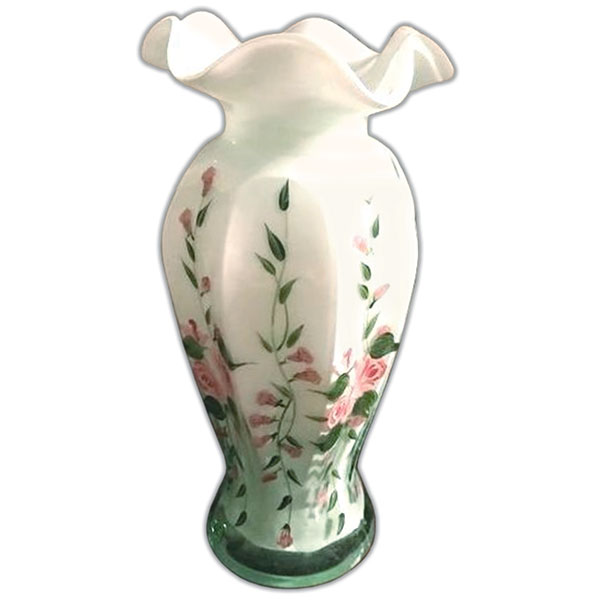Fake Fenton Art Glass — Tips on Spotting Reproductions
Reproduction or “Made in China” Fenton art glass has been appearing on online auction sites and even in antique store displays. You can spot the true art glass made by Fenton Glass artisans in America. Collectors should always look for Fenton glass marks, artist signatures and artistic style to determine if the piece is authentic.
Fenton Art Glass, known for its beautiful colors and patterns, was founded in 1905 by brothers Frank L. and John W. Fenton in Martins Ferry, Ohio. They began by painting decorations on glassware made by nearby manufacturers. The brothers opened their own factory, the Fenton Art Glass factory, in Williamstown, West Virginia, in 1907. “Iridescent ware,” now known as “Carnival” glass, was introduced that same year.
Starting in the Depression and during the early years of World War II, Fenton began making practical items like mixing bowls and perfume bottles. By the late 1940s, brothers Frank M. and Wilmer C. (Bill) Fenton took over the factory. In 1986, George W. Fenton, Frank’s son, became president. Production continued with new colors, patterns and hand-painted decorations. Traditional glassmaking stopped in 2011. The Fenton Art Glass Company property was sold in 2017.
Two of the most frequent reproductions seen are a small vase with a light blue crest and painted red roses on milk glass, and a taller vase usually either purple or green. Both have the ruffled rim, a hallmark of Fenton pieces. Neither is marked Fenton, or signed by the artist. Only very early pieces were unmarked.
How to identify authentic Fenton:
Authentic Fenton, except for the very earliest pieces, is marked.
The artist always signed the decoration, except very early pieces.
If the painting style is rough, it is a reproduction. Fenton had talented artists.
Pieces with a Fenton International logo were outsourced by Fenton to be made in China in later years. The Fenton pieces were functional housewares, not art glass collectibles, according to Butterfly Net, published by the Fenton Art Glass Collectors of America.
Fenton designed — but didn’t make — shapes for the florist company Teleflora. The Teleflora vases, while looking like Fenton, were made in China. Teleflora has a thick base.
FYI
In addition to Kovels.com, there are several clubs and organizations to help collectors avoid fakes: The Fenton Art Glass Collectors of America, FentonArtGlass.com; The National Fenton Glass Society, P.O. Box 4008, Marietta, OH 45750, NFGS.org; The Pacific Northwest Fenton Association, P.O. Box 3901, Hillsboro, Oregon, 97123, email at pnwfa1@yahoo.com; Fenton Fanatics, FentonFan.com; and Heart of America Carnival Glass Association, HOACGA.com.
Photos are courtesy of the Butterfly Net, a publication of the Fenton Art Glass Collectors of America (FAGCA).

The two forms above were designed by Fenton but were not made or decorated by Fenton. The thick glass in the base is a giveaway that it wasn’t made at Fenton.

Neither of the two vases above is Fenton. The painting style is rough and the vase isn’t signed by the artist. These are found frequently on eBay and in questions on Facebook groups.

Fenton Tangerine stretch glass fan vase, No. 847 from the 1920s, will be listed in Fenton books that cover that period.

During the 2017 collector’s convention, the Fenton Gift Shop had several old Log Cabin on custard glass items (made 1976 to 1983) for sale that must have been found in some forgotten corner of the factory. They were priced high, and the rest of the found pieces went quickly.

Roses on Paisley covered candy box made by Wave Crest for Fenton Art Glass Collectors of America in 2005. Here, the paisley relief extends up onto the cover’s finial.

A Dave Fetty/Kelsey Murphy/Robert Bomkamp carved mosaic “Maiden Fern” vase was made by making the entire vase the overlaid mosaic color and then carving away the mosaic to make the design against the underlying ebony satin. This produced a thin-walled vase which often broke during carving, leaving a finished example with an expensive retail price of $695. This one was No. 74 of a limited edition of 350.
4 responses to “Fake Fenton Art Glass — Tips on Spotting Reproductions”
Leave a Reply
You must be logged in to post a comment.





@Lisa Beasley, yes, we do. What would you like to know? Also, if you have any questions about an antique, please send us an email at CollectorsGallery@Kovels.com with pictures of your item.
Does anyone monitor these comments and respond?
Did Fenton make milk glass? If so, did Fenton make milk glass in a Hobnail pattern? And also, if so, is Fenton Hobnail pattern milk glass collectable and or valuable?
I want to thank you for this article. It is sure to help a lot of new Fenton Glass collectors!
I’ve got a question though??, and I’d love for anyone with knowledge on the subject, to please weight in!, Any help or advice is appreciated..
I belong to many Glass/Art- glass and pottery groups on Facebook. Recently there has been several comments made, in various groups, regarding ruffles done on assorted pieces of glass, from Italy, Bohemia and the USA. Many people seem to think that the Fenton ruffles in particular, were done in a flat fashion, while others (other countries versions of the glass ruffles) were done in a Upward fashion instead.
I find this confusing and well, just a bit to easy, to explain many years of glassmaker’s wares in many different places! And then used as a hard and fast rule to ID so many assorted types of ruffled wares?? I guess I never put much thought in on it before…. Are Fenton ruffles more flattened, or evened off? and those done in Italy, Bohemia and other parts of Europe, done with the ruffles rather up and down, or sort-of leaning more upward instead?
Again Thanks for any insight or help!